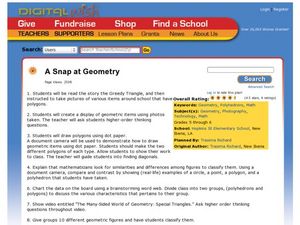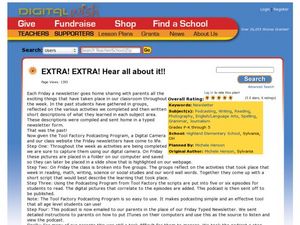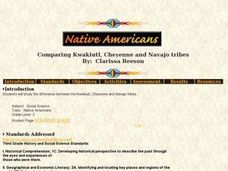Curated OER
A Snap at Geometry
Students study geometric images and polyhedrons. In this geometry instructional activity, students complete several activities to learn about geometric shapes and classify polyhedrons from polygons. Students watch a video, complete a...
Curated OER
Flight of the Painted Ladies
Students explore the life cycle of the Painted Lady Butterfly. They set up cameras near a butterfly culture. They create an iPhoto photo book to document and journal their observations of the metamorphosis. Students produce a narrated...
Curated OER
Symmetry and Geometric Shapes on Campus
Build on your learners' previous knowledge of geometric shapes and symmetrical figures. Then set them out to take photos of geometric shapes on campus. They assess whether the photos contain symmetry or not.
Curated OER
The History and Future of Flight
Students create a PowerPoint presentation and oral report on the history and future of flight. In this flight lesson, students work in small groups to research the history and future of flight. Students then write a report with...
Curated OER
ICT/Literacy
Deepen understanding of email correspondence. Begin by tapping into prior experience with email and word processing. Learners then send emails to one another, practicing attaching images and copying and pasting their work into a word...
Curated OER
Feelings From A to Z
Third graders express and interpret information and ideas. They identify a variety of feelings and their effect on people. They explain how someone's actions can cause someone else to have a specific feeling.
Curated OER
Feelings From A to Z
Third graders create a class A to Z Feelings book to explore emotions, discover new words, pose for a "feeling" icture, and write about the feeling.
Curated OER
My Community: Then and Now
Students compare and contrast their community to what it was like 50 years ago. They research various aspects of their community and compare and contrast with what it is like now. Students present and discuss their findings.
Curated OER
How Caves Are Formed
Students explore caves. For this cave formation lesson, students take a virtual tour of a cave and then participate in a scientific investigation that requires them to grow crystals and chart data regarding their growth.
Curated OER
Passport to the Eastern Hemisphere
Seventh graders explore the Eastern Hemisphere. They investigate the customs, currency, climate, location and other facts needed in order to travel to a specific country. Students receive a stamp on their "passport" when their research...
Curated OER
Mi casa es su casa
Assume the role of a real estate agent and give your prospective buyers a tour of the home you're selling! High schoolers will love putting together a presentation to showcase their home. After completing the PowerPoint presentation,...
PBS
Journalism in War Time: What Does the Public Need to Know?
A viewing of the documentary War Feels Like War, launches an exploration of the importance of accurate and comprehensive war reporting. Groups investigate various news agencies and assess the factors that influence their stories. A...
Curated OER
Mystery Lessons
Learn about mysteries with your readers. They will investigate plot, basic elements of mystery, famous characters, and become familiar with genre vocabulary. Bring in props and mystery books to begin and then have learners create story...
Curated OER
Parts of a Plant
First graders discover the parts of a plant. In this science lesson, 1st graders identify and label the parts of a plant and record their findings on a word processor.
Curated OER
Extra! Extra! Hear All About It!
Young scholars summarize their weekly class activities by writing a newsletter. In this journalism lesson plan, students create a multimedia presentation for their parents based on the classroom events that took place during the...
Curated OER
Sports and Sir Isaac Newton
Eighth graders choose a sport to observe and capture pictures of Newton's Laws of motion in action within the sport. They import these pictures into Avid Cinema to create a multimedia project to go along with the written report and oral...
Curated OER
Cloud in a bag
Students relate the states of matter and clouds. In this environment lesson, students create a chart of information they know about clouds. Students put an ice cube in a bag and tape to a window. Students watch for...
Curated OER
What Tree is That?
Students examine leaves and the trees in their neighborhood that they came from. In this ecology lesson, students read the book, I Can Name 50 Trees Today, and discuss how a tree goes from a forest to a wood shop. Students...
Curated OER
Recycling and Composting
Students set up composting sites that allow food scraps and paper to be recycled by nature. They are introduced to one aspect of recycling; composting. Students see how God recycles as the worms change garbage into something that brings...
Curated OER
Let's Rock
Students investigate the property of rocks and how to distinguish among the different types. They explore the hardness of rocks and perform streak tests to determine mineral color. They classify rocks according to their properties.
Curated OER
Understanding James Madison The Father of the Constitution
Students research James Madison and create a table of his strengths and weaknesses. In this James Madison instructional activity, students read Jean Fritz's, The Great Little Madison, while developing their research skills, vocabulary...
Curated OER
Comparing Kwakiutl, Cheyenne and Navajo tribes
Third graders study the difference between the Kwakiutl, Cheyenne and Navajo tribes. They identify the people, resources, lifestyle and beliefs of the Kwakiutl, Cheyenne, and Navajo Indians. Afterward, they present their projects on each...
Curated OER
Nurture Poetry
Students create a poetry book. In this poetry lesson, students write a cinquain poem, name poem, haiku, limerick, and preposition poem.
Chicago Botanic Garden
Preparing for Project BudBurst
Plants take cues from the environment—change in daylight hours and temperature—to complete their seasonal life cycles. Lesson four in the series of six has classes collect phenology data on plants. After taking initial observations,...























